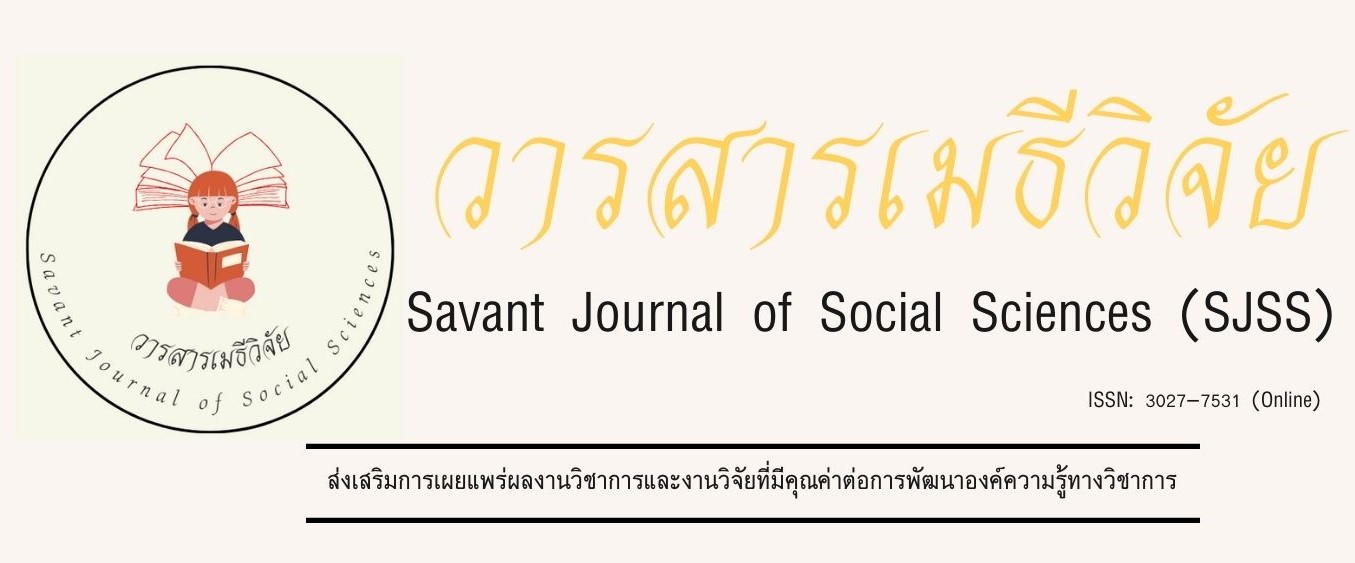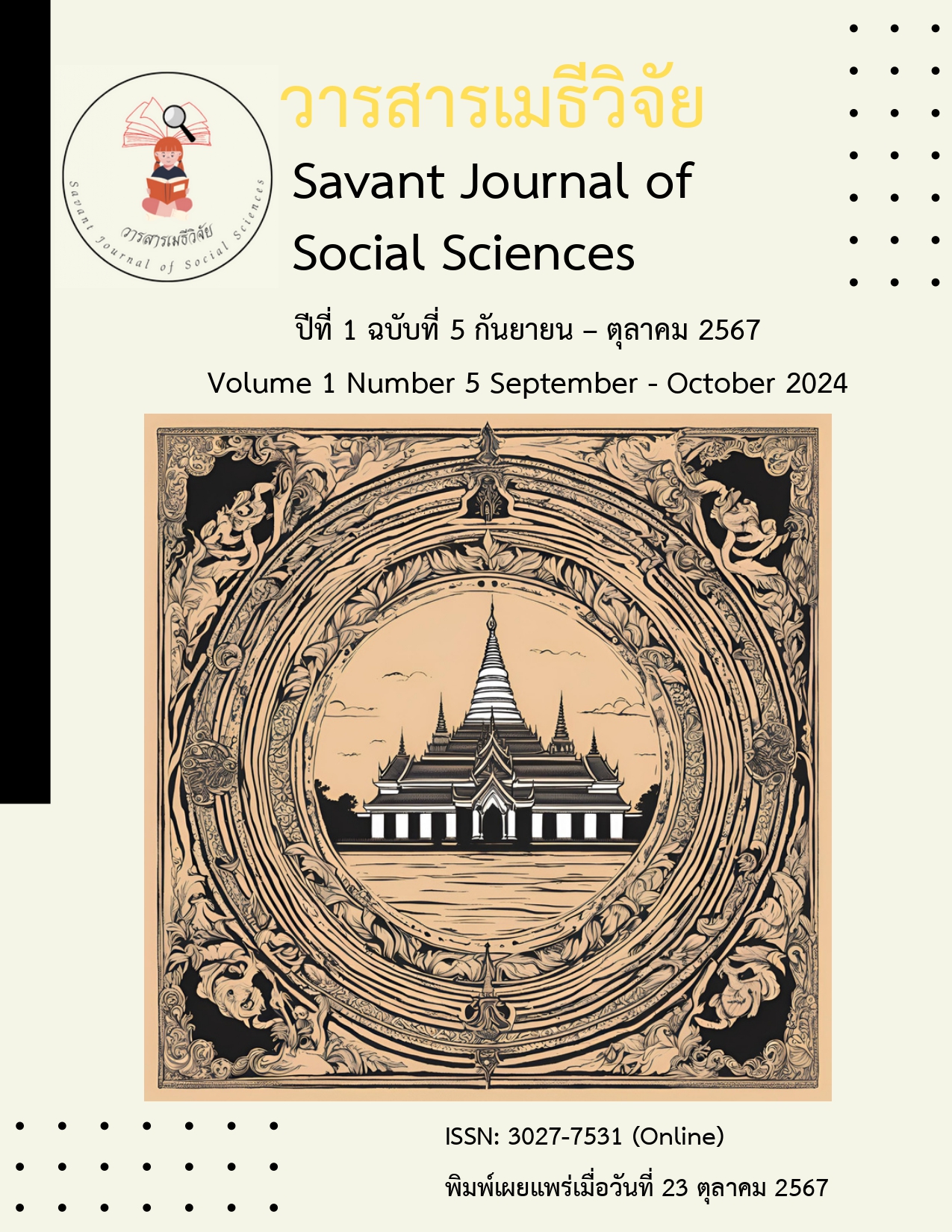Potential Management of Community Enterprise Groups Case Study of the Silk Weaving Group Ban Sang Village, No. 6 Bueng Nakhon Sub - district, Thawatchaburi District, Roi Et Province
Keywords:
Potential, Management, Community Enterprise GroupsAbstract
This research aims to 1) studying the management potential of community enterprise groups, 2) analyzing problems and obstacles in managing community enterprise groups, and 3) suggesting ways to solve problems and obstacles in managing potential community enterprise groups. By this research method, analyzing Through qualitative research using in-depth interviews from sample groups. It consists of 8 target groups: 1) the president of the enterprise group, 2) the vice president of the enterprise group, 3) secretaries, 4) production department, 5) marketing department, 6) members of the enterprise group, and 7) community development officers. The results of the study of the management potential of the Ban Sang Community Enterprise Group found that the group president and members of the enterprise group were always adapting to keep up with the situation. thus resulting in smooth work Know how to adapt in order to approach those things, so that success will be achieved as intended for both leaders and followers. Issues, problems and obstacles in the management potential of the Ban Sang community enterprise group. It was found that most of the problems were due to the lack of members coming to work in the group. And the problem of the spread of COVID-19 and the issue of ways to solve problems and obstacles in managing community enterprise groups, it was found that there should be a meeting to brainstorm ideas. exchange of knowledge Help each other solve problems that arise. in order to be able to operate efficiently.
References
กรมส่งเสริมการเกษตร. (2549). วิสาหกิจชุมชน. กรุงเทพฯ : กรมส่งเสริมการเกษตรกระทรวงเกษตร และสหกรณ์.
เกรียงศักดิ์ เขียวยิ่ง. (2539). การบริหารทรัพยากรมนุษย์และบุคคล. ขอนแก่น : คณะมนุษยศาสตร์และสังคมศาสตร์ มหาวิทยาลัยขอนแก่น.
จิระภา ฉิมสุข. (2544). ศักยภาพของชุมชนในด้านทันตสาธารณสุข. ขอนแก่น : มหาวิทยาลัยขอนแก่น.
จักรพงษ์ นวลชื่น. (2560). แนวทางการพัฒนาวิสาหกิจชุมชนให้ยั่งยืนด้วยภูมิปัญญาท้องถิ่น ศึกษากรณี วิสาหกิจชุมชนในจังหวัดนครพนมและจังหวัดสกลนคร. กรุงเทพฯ : วิทยาลัยป้องกันราชอาณาจักร.
ชูชัย สมิทธิไกร. (2558). การฝึกอบรมบุคลากรในองค์การ. (พิมพ์ครั้งที่ 9). กรุงเทพมหานคร : สำนักพิมพ์แห่งจุฬาลงกรณ์มหาวิทยาลัย.
ดนัย เทียนพุฒ. (2541). รูปแบบของการพัฒนาบุคลากร. กรุงเทพมหานคร : เอ็กซ์เปอร์เน็ท.
ทองใบ สุดชารี. (2542). ทฤษฎีองค์การ : วิเคราะห์แนวความคิด ทฤษฎี และการประยุกต์. ภาควิชาบริหารธุรกิจ คณะวิทยาการจัดการ. อุบลราชธานี : สถาบันราชภัฏอุบลราชธานี.
บัณฑร อ่อนดำ และ วิริยา น้อยวงศ์นยางค์. (2533). ยุทธศาสตร์ในการพัฒนาชนบทประสบการณ์ของประเทศไทย. (พิมพ์ครั้งที่ 1). กรุงเทพมหานคร : มหาวิทยาลัยธรรมศาสตร์.
วิจิตร อาวะกุล. (2540). การฝึกอบรม. (พิมพ์ครั้งที่ 2). กรุงเทพมหานคร : จุฬาลงกรณ์มหาวิทยาลัย.
สมคิด บางโม. (2558). องค์การและการจัดการ. (พิมพ์ครั้งที่ 7). กรุงเทพมหานคร : วิทยพัฒน์.
สายพิณ สันทัด และคณะ. (2551). การศึกษาความต้องการของการพัฒนาศักยภาพของชุมชน. รายงานวิจัย. กรุงเทพมหานคร : สถาบันวิจัยและพัฒนา มหาวิทยาลัยรามคำแหง.
สุกัลยา กรรณสมบัติ. (2543). ศักยภาพของมัคคุเทศก์ต่อการเป็นผู้นำในการท่องเที่ยวเชิงนิเวศ. กรุงเทพมหานคร : มหาวิทยาลัยมหิดล.
เสรี พงศ์พิศ. (2548). ฐานคิดจากแผนแม่บทสู่วิสาหกิจชุมชน. กรุงเทพมหานคร : พลังปัญญา.
สำนักงานคณะกรรมการพัฒนาการเศรษฐกิจและสังคมแห่งชาติ สำนักนายกรัฐมนตรี. (2549). แผนพัฒนาเศรษฐกิจและสังคมแห่งชาติ ฉบับที่ 10 (พ.ศ. 2550 - 2554). กรุงเทพฯ.
อนุชาติ พวงสำลี และ อรทัย อาจอ่ำ. (2539). การพัฒนาเครื่องชี้วัดคุณภาพชีวิตและสังคมไทย. กรุงเทพมหานคร : สำนักงานกองทุนสนับสนุนการวิจัย.






